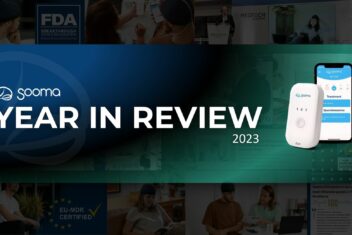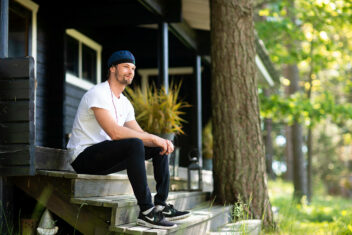Anne Panhelainen: from the Academy to the private sector to impact change

This blog post inaugurates a new series that we have called Sooman Stories. In those, we will share the ideas, thoughts, and experiences of our Soomans through various formats, from interviews to personal reflections, so you can have a look behind the scenes and see what makes Sooma so unique.
On this occasion we interviewed our Clinical Process Manager, Dr. Anne Panhelainen (Ph.D.), to learn a bit more about her and the reasons why she took a leap of faith from the academic world to the start-up environment.
When she was younger, Anne wanted to be a medical doctor. However, by the end of high school, she realized that the thing that pulled her most towards that profession was the science of medicine, more than the practice itself. That is why she pursued a Biology Degree at the University of Oulu and later specialized in electrophysiology and neuroscience at the University of Helsinki. For her Ph.D., she chose neuropharmacology at the Faculty of Medicine, as she realized the importance of using pharmacological tools for brain research.
During her academic career, Anne focused on dopamine neurotransmitters and their role in mediating addiction development. Later in her career, she focused on the mechanisms behind Parkinson’s disease. This turn gave her the chance to be a guest-researcher of NYC Columbia University, where she started her work on pre-clinical drug development for neurodegenerative disorders. This she continued when returning to Helsinki University, where she also taught at the International Neuroscience program. The important key topics in Anne’s academic research have been neuroplasticity and protein quality control and how to affect those to help neurons survive and even recover in neurological diseases.
What made you pursue a career change from the public sector?
I think that after working on very complex, vast, and at points abstract neuroscientific questions for over 15 years, I began to look for a more practical level of neuroscience. The neuroprotective and -restorative treatments that I was dreaming of developing felt very much like a distant future. I was frustrated that I could not help people already now.
Also, the struggle with funding and tough competition is real in the academy and was getting more intense when you advance towards the higher positions. I realized that the academic world has a lot of politics involved so I felt like my time was not getting invested so much in science anymore. It was just time for me to take my expertise and move to a place where I feel I’m using it in a better way.
Why did you choose to apply to Sooma?
Every now and then, while attending research seminars and congresses, I’d come across the neuromodulation methods and got very interested in those, also at the clinical level. As I realized that these therapies are already being used to treat people, especially in depression, I became very excited about them. Especially when being very aware of the big problems related to the current commonly used pharmacological treatments. Then I came across Sooma, a Finnish company, and I immediately felt very strongly that it was something I wanted to be involved with. That was the chance I was looking for: something that is already being used to very effectively and safely affect the brain function in treating diseases.
Also, I loved the Sooma concept of offering an accessible treatment that is as simple as possible but still consistent, controlled, and efficient, with very wide availability. So, I could not let this opportunity go.
What do you like the most about your job at Sooma?
Sooma’s mission was very inspiring for me because depression affects such a big portion of the population, not only a very narrow niche. Depression is a disease that somehow touches everyone, so I felt that I had the opportunity to make a big impact working to treat it.
When you are working in a company like Sooma you can truly do good for the whole world. In Sooma I still feel like I’m fully using my scientific skills, because I’m planning, collecting, and analyzing science daily, and following the advancements of the field. In addition, this position allows me to learn a huge amount of new skills related to start-up, medical devices, and their development and regulation. Really, I couldn’t think of a better place for me.
What are the main differences between university and private research processes?
It’s a different world. The science is basically the same, but when working in a company, everything is focused on a product: that it is the best possible, that it does what it’s supposed to do in the best possible way, that it fills all the requirements set by patients, doctors, and regulators… Everything starts from and ends with the product. In academic basic science, on the other hand, the focus is not so concrete. You have many research questions all the time and you try to find hints that guide you in some direction. In a small company that only has a few products, everything is much more concrete and the aims are very clear and focused. And this fits me very well now!
However, I must say that I was very lucky in the academy because I had very good mentors who were also very application-oriented, so they did science with an eye on the practical applications that should arise from it. My mentors had discovered several patents and even started companies, so I was also in touch with that world, luckily.
These people also encouraged me to look outside of the academy and made me feel that it is not a failure in science if you leave the academic world.
Which has been the biggest challenge in the transition from public to private?
I don’t feel that any challenge is too big. The places where I have learned the most in my life are those where I had the most difficulties. I like learning so I think of difficult tasks as opportunities and not challenges.
It was nice to change careers so dramatically after 15 years in the academy because it is a chance to learn again. Definitely not too big of a step from the academy and most definitely not too late. So, if you feel like you need a change and have the opportunity, you should take it.
What would be your “dream accomplishment” to fulfill while working for Sooma?
To keep Sooma going and make it bigger. Just to work hard for Sooma’s success would mean that we would see many patients being treated with tDCS and getting good results, so that would fulfill my goal of being able to help people now.
The depression tDCS treatment has developed into a very great success already so now I hope that we can get it more widely used to spread the therapeutic impact on the patients. For the future I’m dreaming to see other indications, like pain tDCS treatment, becoming as vast of a success story as it certainly deserves to be.
What would you tell any girl or young woman wanting to pursue a career in STEM?
That you should study what you are interested in. If it’s in the STEM field, there’s no reason not to follow that interest. I hope that all those little ones have teachers or people around them that support their motivations. That is how I did it: I just always liked studying biology, physics, and chemistry so I chose this type of path in high school and followed that for a university degree. Just follow your interest. I just wish everybody had a chance to do that.
It is true that in high school, being a girl in the science classes, I was part of a minority, but that was not a problem. In fact, often the boys came to us girls before the teacher arrived at the classroom to check from us how we had solved the homework.
If you also find Sooma’s mission inspiring and want to help advance the Sooma Depression Therapy (indicated for Major Depressive Disorder) and Sooma Pain Therapy (indicated for Fibromyalgia and chronic neuropathic pain) use in the medical community, take a look at our career page for open positions.


